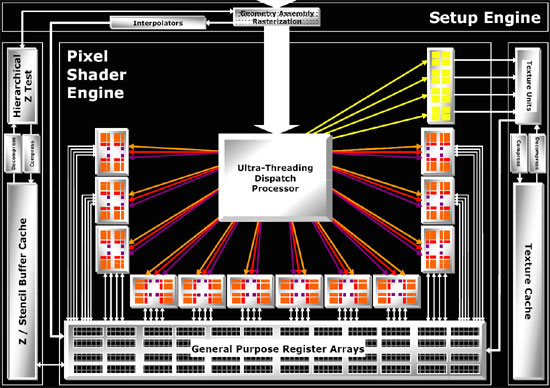Page 2
Alright, let's start off with a generic chat on the graphics core of this graphics card. ATI's new flagship chips were developed under codename R580. Radeon X1900 (or R580 core) is in numerous ways what the R520 core should have been when it was launched. R580 uses the same memory controller found on R520, with that wicked 512-bit internal ring bus controller. Externally, the chip addresses memory with 256-bits. The R580 core still features 16 pixel pipelines yet now has 48 Pixel Shader processors. R580 is produced on a 90nm process.
Let's talk transistor count, make an estimated guess, how many transistors do you think the X1900 chip has? The X1900 chip my fellow guru's has just over 380 million transistors, that makes you think huh? NVIDIA's 7800 for example already passed 304 million and the X1800 XT had 321 million. But yeah, we are now at a stage where we are nearing 400 million transistors. Smaller fabrication processes help the companies do this. That manufacturing process is at the newer 90nm right now.
Why the massive increase of Pixel Shader cores you ask? Simple, rendering cinematic effects as fast as possible because these are being created by pixel shaders.
 Here we see the pixel engine .. 12 x 4 - 48 Pixel units, each unit is organized in a quad.
Here we see the pixel engine .. 12 x 4 - 48 Pixel units, each unit is organized in a quad.
So the increased Pixel Shader capacity of course is the biggest change in the design of this graphics chip architecture. A pixel pipeline pretty much consists of a pixel shader processor, a texture mapping unit (TMU) and a Raster OPerator unit (ROP). ATI has sort of designed their pixel pipelines such that the pixel shader processors are more independent, while NVIDIA has their ROP units independent.
Really you can compare this X1900 product with the X1800 series in almost every way, yet the focus here is absolutely on the 48 Pixel Shader units. Each Pixel Shader processor can handle anything from 1 to 5 shader instructions per clock cycle in its various ALUs. With 48 pixel processors the 1900 series has three times more arithmetic shading processing power when compared with the previous flagship product, the X1800 XT. ATI believes that the 3:1 ratio of arithmetic to texture units provides the ideal balance for current and future 3D performance.
To give you an more understandable example: the X1800 could manage 60 million Pixel shader operations per second. The X1900 series can do 166 million. With the focus on Shader Model 2 and 3, that alone is the money shot right there, let's not forget that Shader Model 3.0 has finally become very important.
| What is a shader ? |
| What do we need to render a three dimensional object; 2D on your monitor? We start off by building some sort of structure that has a surface, that surface is being built from triangles and why triangles? They are quick to calculate. How's each triangle being processed? Each triangle has to be transformed according to its relative position and orientation to the viewer. Each of the three vertices the triangle is made up of is transformed to its proper view space position. The next step is to light the triangle by taking the transformed vertices and applying a lighting calculation for every light defined in the scene. At last the triangle needs to be projected to the screen in order to rasterize it. During rasterization the triangle will be shaded and textured. |
